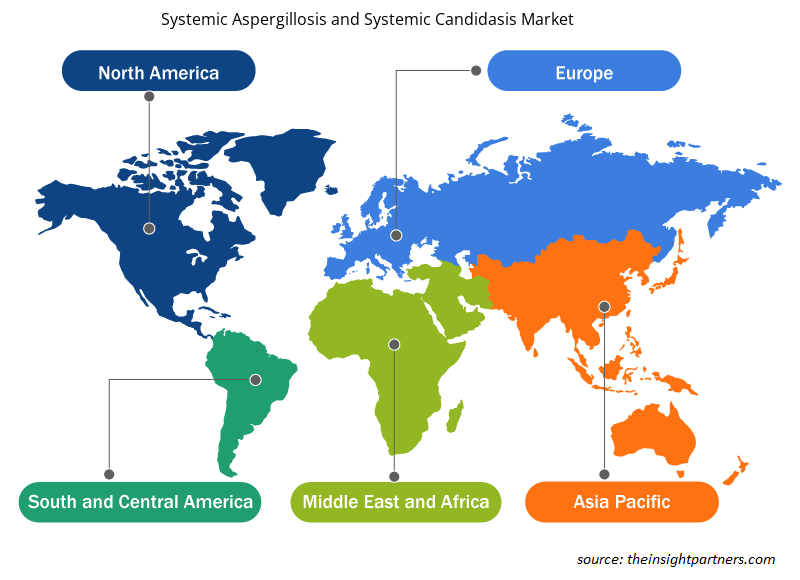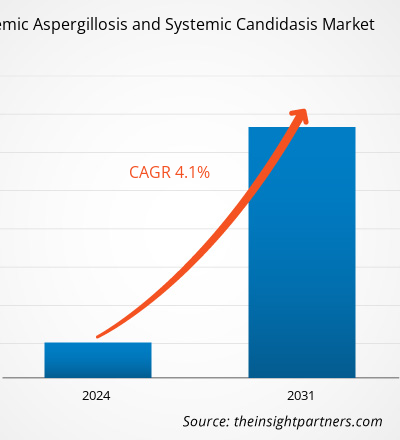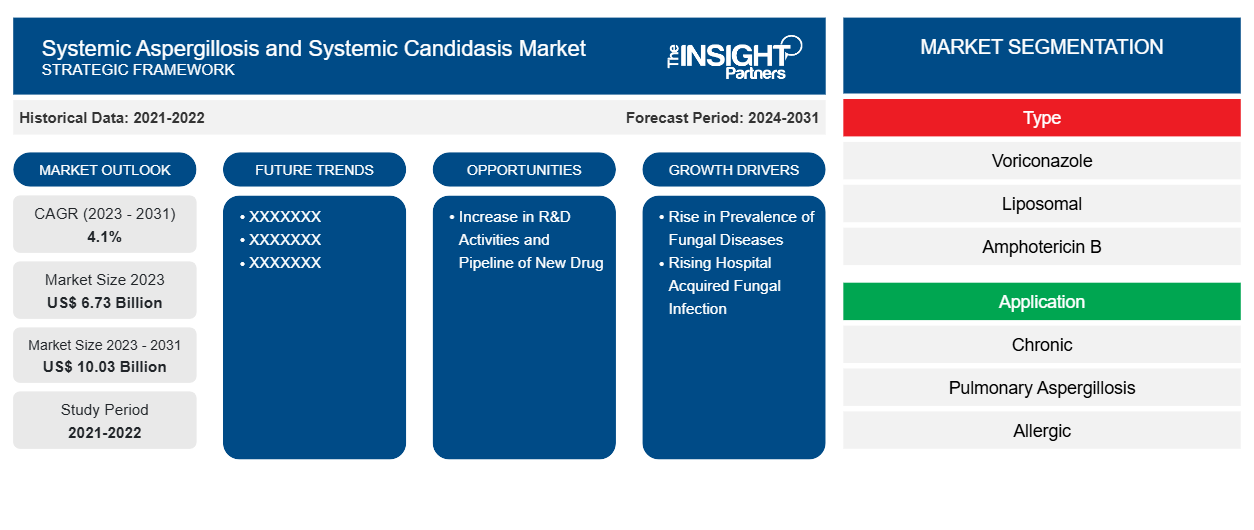Si prevede che la dimensione del mercato dell'aspergillosi sistemica e della candidosi sistemica raggiungerà i 10,03 miliardi di dollari entro il 2031, rispetto ai 6,73 miliardi di dollari del 2023. Si prevede che il mercato registrerà un CAGR del 4,1% nel 2023-2031. Lo sviluppo di nuove terapie per il trattamento delle malattie fungine, l'aumento delle attività di ricerca e sviluppo per lo sviluppo di farmaci e l'aumento delle malattie fungine contratte in ospedale rimarranno probabilmente le tendenze chiave del mercato dell'aspergillosi sistemica e della candidosi sistemica.
Analisi di mercato dell'aspergillosi sistemica e della candidosi sistemica
C'è un aumento della prevalenza di aspergillosi sistemica e candidosi sistemica dovuto ai crescenti problemi di salute. Poiché il sistema immunitario si indebolisce a causa della pandemia di HIV/AIDS, della tubercolosi, della broncopneumopatia cronica ostruttiva (BPCO), dell'asma e della crescente incidenza di tumori, il paziente è più suscettibile alle malattie fungine. Pertanto, l'aumento della prevalenza di malattie che indeboliscono il sistema immunitario sta alimentando la crescita del mercato dell'aspergillosi sistemica e della candidosi sistemica.
Panoramica del mercato dell'aspergillosi sistemica e della candidosi sistemica
Le infezioni sistemiche fungine sono comuni nei pazienti con sistema immunitario indebolito, tra cui pazienti con immunodepressione e sindrome da immunodeficienza acquisita (AIDS). I segni sistemici consolidano apnea, feci positive al guaiaco, distensione addominale, iperglicemia, reazione leucemoide, ipotensione e altri. Il trattamento della candidosi sistemica e dell'aspergillosi richiede una terapia antimicotica parenterale e questa condizione è associata a un alto tasso di mortalità. Inoltre, questa infezione può causare deficit neuroevolutivi permanenti nei sopravvissuti a lungo termine.
Personalizza questo report in base alle tue esigenze
Riceverai la personalizzazione gratuita di qualsiasi report, comprese parti di questo report, o analisi a livello nazionale, pacchetto dati Excel, oltre a usufruire di grandi offerte e sconti per start-up e università
-
Scopri le principali tendenze di mercato in questo rapporto.Questo campione GRATUITO includerà analisi di dati che spaziano dalle tendenze di mercato alle stime e alle previsioni.
Driver di mercato e opportunità per l'aspergillosi sistemica e la candidosi sistemica
L'aumento delle infezioni fungine acquisite in ospedale favorisce il mercato
Candida Auris è un fungo che causa una grave minaccia per la salute globale. C. Auris causa gravi malattie nei pazienti ospedalizzati in diversi paesi, tra cui gli Stati Uniti. I pazienti C. auris hanno causato epidemie nelle strutture sanitarie e possono diffondersi attraverso il contatto con pazienti affetti e superfici o attrezzature contaminate. può rimanere colonizzato da C. Auris per lungo tempo e C. Auris può persistere sulle superfici negli ambienti sanitari. Ciò può causare la diffusione di C. Auris tra i pazienti nelle strutture sanitarie. Secondo un rapporto del CDC del 2021, casi statunitensi di C. Auris sono stati riscontrati in pazienti che avevano avuto ricoveri recenti in strutture sanitarie in Egitto, India, Kenya, Kuwait, Pakistan, Sud Africa, Corea del Sud, Emirati Arabi Uniti e Venezuela, che hanno anche casi documentati.Auris is a fungus that causes a serious global health threat. C. Auris causes severe illness in hospitalized patients in several countries, including the United States. Patients C. auris has caused outbreaks in healthcare facilities and can spread through contact with affected patients and contaminated surfaces or equipment. can remain colonized with C. Auris for a long time, and C. Auris can persist on surfaces in healthcare environments. This can result in the spread of C. Auris between patients in healthcare facilities. According to a CDC report of 2021, U.S. cases of C. Auris have been found in patients who had recent stays in healthcare facilities in Egypt, India, Kenya, Kuwait, Pakistan, South Africa, South Korea, the United Arab Emirates, and Venezuela, which also have documented cases.
Analisi della pipeline: un'opportunità nella personalizzazione dell'aspergillosi sistemica e della candidosi sistemicaCustomisation of Systemic Aspergillosis and Systemic Candidasis
L'attuale panorama per l'aspergillosi sistemica e la candidosi sistemica è promettente, con molteplici approvazioni di farmaci, una ricca pipeline e molti studi clinici in corso. Le pipeline per l'aspergillosi sistemica e la candidosi sistemica sono in varie fasi di sviluppo clinico; le principali aziende farmaceutiche stanno lavorando per far progredire lo spazio della pipeline e il potenziale di crescita futura del dominio competitivo dell'aspergillosi sistemica e della candidosi sistemica. Ad esempio, Ibrexafungerp Citrate, un farmaco per il trattamento della candidosi sistemica, è attualmente in fase III ed è sviluppato da Scynexis.aspergillosis and systemic candidasis is promising, with multiple drug approvals, a rich pipeline, and many ongoing clinical trials. Pipelines of systemic aspergillosis and systemic candidasis are in various stages of clinical development; major pharmaceutical companies are working to advance the pipeline space and future growth potential of the systemic aspergillosis and systemic candidasis competitive domain. For instance, Ibrexafungerp Citrate, a drug for treatment of systemic candidiasis, is currently in phase III and is developed by Scynexis.
Analisi della segmentazione del rapporto di mercato sull'aspergillosi sistemica e sulla candidosi sistemicaAspergillosis and Systemic Candidasis Market Report Segmentation Analysis
I segmenti chiave che hanno contribuito alla derivazione dell'analisi di mercato dell'aspergillosi sistemica e della candidosi sistemica sono tipologia e applicazione.Aspergillosis and Systemic Candidasis Market analysis are type and application.
- In base al tipo, il mercato dell'aspergillosi sistemica e della candidosi sistemica è suddiviso in voriconazolo, amfotericina b liposomiale, azoli orali sistemici, agenti antimicotici topici e altri. Il segmento degli azoli orali sistemici ha detenuto la quota di mercato maggiore nel 2023. I farmaci azolici orali come fluconazolo, ketoconazolo e itraconazolo hanno un importante progresso nella terapia antimicotica sistemica. Tra tutti e tre, il fluconazolo ha il profilo farmacologico (farmacocinetica e farmacodinamica) più interessante, inclusa la capacità di produrre elevate concentrazioni di farmaco attivo nel liquido cerebrospinale e nelle urine.Aspergillosis and Systemic Candidasis Market is divided into voriconazole, liposomal amphotericin b, systemic oral azoles, topical antifungal agents and others. The systemic oral azoles segment held the largest market share in 2023. Oral azole drugs such as fluconazole, ketoconazole, and itraconazole have a major advancement in systemic antifungal therapy. Among all the three, fluconazole has the most attractive pharmacologic (pharmacokinetics and pharmacodynamic) profile, including the capacity to produce high concentrations of active drug in cerebrospinal fluid and urine.
- Per applicazione, il mercato è segmentato in aspergillosi polmonare cronica (CPA), aspergillosi broncopolmonare allergica (ABPA), candidosi gastrointestinale , tratto genitourinario, candidosi e altri. Il segmento dell'aspergillosi broncopolmonare allergica (ABPA) ha detenuto la quota maggiore del mercato nel 2023.
Analisi della quota di mercato dell'aspergillosi sistemica e della candidosi sistemica per area geografica
L'ambito geografico del rapporto di mercato sull'aspergillosi sistemica e sulla candidosi sistemica è suddiviso principalmente in cinque regioni: Nord America, Asia Pacifico, Europa, Medio Oriente e Africa e Sud America/Sud e Centro America.
Il Nord America ha dominato il mercato dell'aspergillosi sistemica e della candidosi sistemica. La crescita del mercato della regione è attribuita all'aumento dell'incidenza delle infezioni fungine e al crescente sviluppo e lancio di prodotti, nonché alle crescenti iniziative sulle infezioni fungine e sui loro trattamenti. Inoltre, si prevede che le crescenti spese sanitarie per il trattamento delle infezioni fungine guideranno la crescita del mercato durante il periodo di previsione verso il predominio del mercato dell'aspergillosi sistemica e della candidosi sistemica del Nord America. Si stima che gli Stati Uniti siano il mercato più grande per l'aspergillosi sistemica e la candidosi sistemica. La crescita è attribuita all'aumento dell'incidenza delle infezioni fungine che incoraggia ulteriormente varie aziende farmaceutiche a investire nei loro programmi di ricerca e sviluppo e a introdurre sul mercato medicinali innovativi. Ad esempio, a gennaio 2020, Astellas Pharma Inc. ha annunciato di aver ricevuto l'approvazione dalla FDA per la sua domanda di nuovo farmaco supplementare (sNDA) per MYCAMINE (micafungin per iniezione). Si prevede che l'Asia Pacifica crescerà con il CAGR più elevato nei prossimi anni.
Approfondimenti regionali sul mercato dell'aspergillosi sistemica e della candidosi sistemica
Le tendenze regionali e i fattori che influenzano il mercato dell'aspergillosi sistemica e della candidosi sistemica durante il periodo di previsione sono stati ampiamente spiegati dagli analisti di Insight Partners. Questa sezione discute anche i segmenti e la geografia del mercato dell'aspergillosi sistemica e della candidosi sistemica in Nord America, Europa, Asia Pacifico, Medio Oriente e Africa e America meridionale e centrale.

- Ottieni i dati specifici regionali per il mercato dell'aspergillosi sistemica e della candidosi sistemica
Ambito del rapporto di mercato sull'aspergillosi sistemica e sulla candidosi sistemica
| Attributo del report | Dettagli |
|---|---|
| Dimensioni del mercato nel 2023 | 6,73 miliardi di dollari USA |
| Dimensioni del mercato entro il 2031 | 10,03 miliardi di dollari USA |
| CAGR globale (2023-2031) | 4,1% |
| Dati storici | 2021-2022 |
| Periodo di previsione | 2024-2031 |
| Segmenti coperti |
Per tipo
|
| Regioni e Paesi coperti |
America del Nord
|
| Leader di mercato e profili aziendali chiave |
|
Densità degli attori del mercato: comprendere il suo impatto sulle dinamiche aziendali
Il mercato dell'aspergillosi sistemica e della candidosi sistemica sta crescendo rapidamente, spinto dalla crescente domanda degli utenti finali dovuta a fattori quali l'evoluzione delle preferenze dei consumatori, i progressi tecnologici e una maggiore consapevolezza dei benefici del prodotto. Con l'aumento della domanda, le aziende stanno ampliando le loro offerte, innovando per soddisfare le esigenze dei consumatori e capitalizzando sulle tendenze emergenti, il che alimenta ulteriormente la crescita del mercato.
La densità degli operatori di mercato si riferisce alla distribuzione di aziende o società che operano in un particolare mercato o settore. Indica quanti concorrenti (operatori di mercato) sono presenti in un dato spazio di mercato in relazione alle sue dimensioni o al valore di mercato totale.
Le principali aziende che operano nel mercato dell'aspergillosi sistemica e della candidosi sistemica sono:
- Novartis AG
- Sanofi Aventis
- Pfizer, Inc
- Merck e Co., Inc.
- Enzon Pharmaceuticals, Inc
- Bayer AG
Disclaimer : le aziende elencate sopra non sono classificate secondo un ordine particolare.

- Ottieni una panoramica dei principali attori del mercato dell'aspergillosi sistemica e della candidosi sistemica
Notizie di mercato e sviluppi recenti sull'aspergillosi sistemica e sulla candidosi sistemica
Il mercato dell'aspergillosi sistemica e della candidosi sistemica viene valutato raccogliendo dati qualitativi e quantitativi post-ricerca primaria e secondaria, che includono importanti pubblicazioni aziendali, dati di associazioni e database. Di seguito è riportato un elenco di sviluppi nel mercato dell'aspergillosi sistemica e della candidosi sistemica e delle strategie:
- Pfizer ha acquisito Amplyx Pharmaceuticals, Inc. Pfizer si è assicurata la proprietà della pipeline in fase iniziale di Amplyx che include potenziali terapie antivirali (MAU868) e antimicotiche (APX2039). (Fonte: Pfizer, comunicato stampa, 2021)
- Basilea Pharmaceutica Ltd ha stipulato un accordo di acquisto di asset con Amplyx Pharmaceuticals, Inc., un'affiliata di Pfizer Inc., e ha acquisito i diritti su fosmanogepix, un candidato antimicotico ad ampio spettro in fase clinica. Inoltre, Basilea ha acquisito i diritti su un composto antimicotico preclinico. (Fonte: Biospace, Comunicato stampa, 2023)
Copertura e risultati del rapporto di mercato sull'aspergillosi sistemica e sulla candidosi sistemica
Il rapporto "Dimensioni e previsioni del mercato dell'aspergillosi sistemica e della candidosi sistemica (2021-2031)" fornisce un'analisi dettagliata del mercato che copre le seguenti aree:
- Dimensioni e previsioni del mercato a livello globale, regionale e nazionale per tutti i segmenti di mercato chiave coperti dall'ambito
- Dinamiche di mercato come fattori trainanti, vincoli e opportunità chiave
- Principali tendenze future
- Analisi dettagliata delle cinque forze PEST/Porter e SWOT
- Analisi di mercato globale e regionale che copre le principali tendenze di mercato, i principali attori, le normative e gli sviluppi recenti del mercato
- Analisi del panorama industriale e della concorrenza che copre la concentrazione del mercato, l'analisi della mappa di calore, i principali attori e gli sviluppi recenti
- Profili aziendali dettagliati
- Analisi storica (2 anni), anno base, previsione (7 anni) con CAGR
- Analisi PEST e SWOT
- Valore/volume delle dimensioni del mercato - Globale, Regionale, Nazionale
- Industria e panorama competitivo
- Set di dati Excel
Report recenti
Testimonianze
Motivo dell'acquisto
- Processo decisionale informato
- Comprensione delle dinamiche di mercato
- Analisi competitiva
- Analisi dei clienti
- Previsioni di mercato
- Mitigazione del rischio
- Pianificazione strategica
- Giustificazione degli investimenti
- Identificazione dei mercati emergenti
- Miglioramento delle strategie di marketing
- Aumento dell'efficienza operativa
- Allineamento alle tendenze normative























 Ottieni un campione gratuito per - Mercato dell'aspergillosi sistemica e della candidosi sistemica
Ottieni un campione gratuito per - Mercato dell'aspergillosi sistemica e della candidosi sistemica